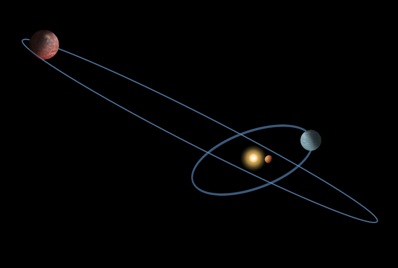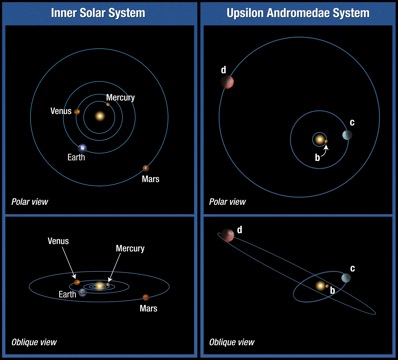


|

|
 |
|
Unusual exoplanet orbits suggest violent past DR EMILY BALDWIN ASTRONOMY NOW Posted: 25 May 2010 Two planets discovered orbiting their host star at highly inclined angles could impact theories of how multi-planet systems evolve. The results were reported at the 216th American Astronomical Society meeting in Miami yesterday by Barbara McArthur of The University of Texas at Austin’s McDonald Observatory, who used data from the Hubble Space Telescope and numerous ground-based telescopes to study the orbits of the three known planets around the star Upsilon Andromedae. "The findings mean that future studies of exoplanetary systems will be more complicated," she says. "Astronomers can no longer assume all planets orbit their parent star in a single plane."  Illustration of the Upsilon Andromedae A planetary system showing planet c and d's highly inclined orbits. Image: NASA, ESA and A. Feild (STScI). Illustration of the Upsilon Andromedae A planetary system showing planet c and d's highly inclined orbits. Image: NASA, ESA and A. Feild (STScI).
Astronomers already knew that three Jupiter-type planets orbit the star, which is similar to our own Sun albeit a little younger and more massive, but the new study enabled detailed analysis of the nature of their orbits, finding that two of the planets' orbits – planet c and d – are inclined by a staggering 30 degrees to each other. “Most probably Upsilon Andromedae had the same formation process as our own Solar System, although there could have been differences in the late formation that seeded this divergent evolution,” says McArthur. “The premise of planetary evolution so far has been that planetary systems form in the disc and remain relatively co-planar, but now we have measured a significant angle between these planets that indicates this isn’t always the case.” Even our own Solar System has its oddities: dwarf planet Pluto's orbit is inclined to the ecliptic by nearly 20 degrees, and Eris by over 40 degrees. These orbits have likely been modified by the gravitational influence of Neptune. It was also recently reported that a number of exoplanets detected by the SuperWASP consortium orbit their host stars in the opposite direction to the spin of their star (read more here), showing that not all planetary systems conform to textbook examples. Migration of planets inwards towards their star, the ejection of planets from the system due to planet-planet interactions, or disruptions due to a binary star companion could all play a role in shaping these curious systems.  Our Solar System and the Upsilon Andromedae system compared. Image: NASA, ESA and A. Feild (STScI). Our Solar System and the Upsilon Andromedae system compared. Image: NASA, ESA and A. Feild (STScI).
Team member Rory Barnes of the University of Washington thinks that in the case of the Upsilon Andromedae system, the inclined orbits probably resulted from the ejection of an original member of the planetary system. "However, we don’t know if the distant stellar companion forced that ejection, or if the planetary system itself formed in such a way that some original planets were ejected," he says. "Furthermore, we find that the revised configuration still lies right on the precipice of instability: The planets pull on each other so strongly that they are almost able to throw each other out of the system.” Upsilon Andromedae's binary companion is a red dwarf star much dimmer and less massive than our Sun. “We don’t have any idea what its orbit is,” says Benedict. “It could be very eccentric. Maybe it comes in very close every once in a while. It may take 10,000 years.” The team also determined masses for the planets, turning previous estimates made using the radial velocity technique (measurements of the star's motion on the sky towards and away from the Earth) on their heads. Until now it was thought that planet c was at least two Jupiter masses, and planet d four Jupiter masses. Now, using new precision astrometry data – the measurements of the positions and motions of bodies, in this case using Hubble's Find Guidance Sensors – exact masses of 14 Jupiters for planet c and 10 Jupiters for planet d have been determined. Radial velocity measurements collected over 14 years using ground-based telescopes provided even more precise information on the nature of the planets' orbits, and also yielded clues that a fourth planet might be orbiting even further out, but the signal is faint – the planet is so distant that the data does not yet indicate curvature in its orbit. |
|
|
|
|